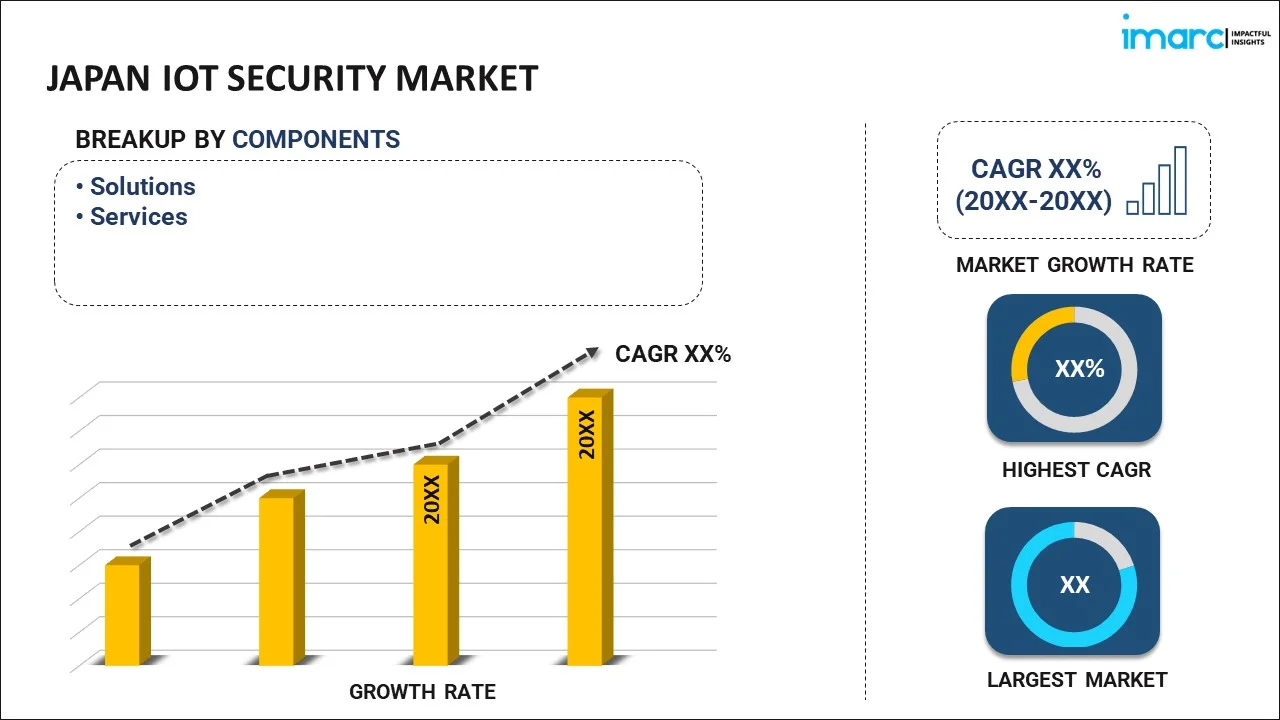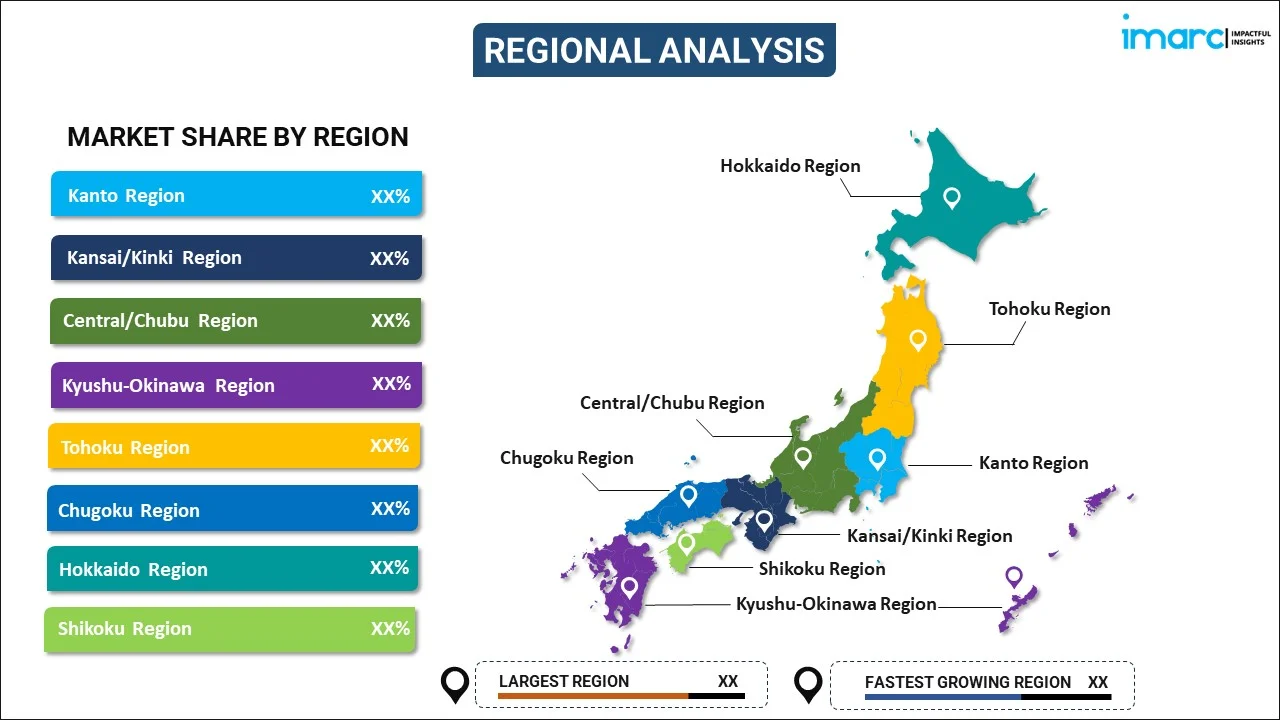
Japan IoT Security Market Report by Component (Solutions, Services), Security Type (Network Security, Endpoint Security, Application Security, Cloud Security, and Others), Vertical (Energy and Utilities, Manufacturing, Automotive, Transport, Consumer Electronics, Healthcare, and Others), and Region 2025-2033
Market Overview:
Japan IoT security market size reached USD 321.3 Million in 2024. Looking forward, IMARC Group expects the market to reach USD 2,163.1 Million by 2033, exhibiting a growth rate (CAGR) of 21.6% during 2025-2033. The increasing prevalence of high-profile security breaches and incidents related to IoT devices that have raised awareness about the vulnerabilities in these systems, is primarily driving the market.
|
Report Attribute
|
Key Statistics
|
|---|---|
|
Base Year
|
2024 |
|
Forecast Years
|
2025-2033
|
|
Historical Years
|
2019-2024
|
| Market Size in 2024 | USD 321.3 Million |
| Market Forecast in 2033 | USD 2,163.1 Million |
| Market Growth Rate (2025-2033) | 21.6% |
IoT (Internet of Things) security refers to the protective measures and strategies employed to safeguard Internet-enabled devices and the networks they're connected to. With the exponential growth of smart devices, from wearable tech to smart home systems, the potential for cyber threats and breaches has also surged. These devices, which often communicate without human intervention, can be gateways for hackers if left unprotected. Weak security can lead to unauthorized access, data theft, or malicious control of the devices. Consequently, IoT security emphasizes the need for rigorous cybersecurity practices, including secure coding, encrypted communications, and regular firmware updates. Furthermore, it encompasses the integration of physical security with cybersecurity, ensuring that devices are safe from tampering and eavesdropping. As the IoT ecosystem expands, proactive defense against potential vulnerabilities becomes crucial, necessitating collaboration between manufacturers, developers, and end-users. In sum, IoT security is not just about protecting individual devices but ensuring the safety and privacy of the interconnected digital and physical world.
Japan IoT Security Market Trends:
The IoT security market in Japan is experiencing robust growth due to several key drivers. Firstly, the proliferation of IoT devices across various industries has significantly expanded the attack surface for cyber threats. Consequently, organizations are increasingly recognizing the critical need for robust security solutions to safeguard their interconnected ecosystems. Furthermore, the rising frequency and sophistication of cyberattacks targeting IoT devices have raised concerns about data breaches, privacy infringements, and potential physical harm. This has propelled the demand for advanced security measures that can detect and mitigate these evolving threats effectively. In addition to these concerns, stringent regulatory mandates and compliance requirements have emerged as powerful catalysts for IoT security market growth. Governments and industry regulators in Japan are pushing for stricter security standards, forcing businesses to invest in comprehensive security solutions to avoid non-compliance penalties and reputational damage. Moreover, the convergence of IoT with other transformative technologies, such as artificial intelligence and edge computing, has created a complex and dynamic threat landscape. This complexity, which has led to a greater demand for sophisticated security solutions that can adapt to these evolving environments, is expected to drive the IoT security market in Japan.
Japan IoT Security Market Segmentation:
IMARC Group provides an analysis of the key trends in each segment of the market, along with forecasts at the country level for 2025-2033. Our report has categorized the market based on component, security type, and vertical.
Component Insights:

- Solutions
- Services
The report has provided a detailed breakup and analysis of the market based on the component. This includes solutions and services.
Security Type Insights:
- Network Security
- Endpoint Security
- Application Security
- Cloud Security
- Others
A detailed breakup and analysis of the market based on the security type have also been provided in the report. This includes network security, endpoint security, application security, cloud security, and others.
Vertical Insights:
- Energy and Utilities
- Manufacturing
- Automotive
- Transport
- Consumer Electronics
- Healthcare
- Others
The report has provided a detailed breakup and analysis of the market based on the vertical. This includes energy and utilities, manufacturing, automotive, transport, consumer electronics, healthcare, and others.
Regional Insights:

- Kanto Region
- Kansai/Kinki Region
- Central/ Chubu Region
- Kyushu-Okinawa Region
- Tohoku Region
- Chugoku Region
- Hokkaido Region
- Shikoku Region
The report has also provided a comprehensive analysis of all the major regional markets, which include Kanto Region, Kansai/Kinki Region, Central/ Chubu Region, Kyushu-Okinawa Region, Tohoku Region, Chugoku Region, Hokkaido Region, and Shikoku Region.
Competitive Landscape:
The market research report has also provided a comprehensive analysis of the competitive landscape. Competitive analysis such as market structure, key player positioning, top winning strategies, competitive dashboard, and company evaluation quadrant has been covered in the report. Also, detailed profiles of all major companies have been provided.
Japan IoT Security Market Report Coverage:
| Report Features | Details |
|---|---|
| Base Year of the Analysis | 2024 |
| Historical Period | 2019-2024 |
| Forecast Period | 2025-2033 |
| Units | Million USD |
| Scope of the Report | Exploration of Historical and Forecast Trends, Industry Catalysts and Challenges, Segment-Wise Historical and Predictive Market Assessment:
|
| Components Covered | Solutions, Services |
| Security Types Covered | Network Security, Endpoint Security, Application Security, Cloud Security, Others |
| Verticals Covered | Energy and Utilities, Manufacturing, Automotive, Transport, Consumer Electronics, Healthcare, Others |
| Regions Covered | Kanto Region, Kansai/Kinki Region, Central/Chubu Region, Kyushu-Okinawa Region, Tohoku Region, Chugoku Region, Hokkaido Region, Shikoku Region |
| Customization Scope | 10% Free Customization |
| Post-Sale Analyst Support | 10-12 Weeks |
| Delivery Format | PDF and Excel through Email (We can also provide the editable version of the report in PPT/Word format on special request) |
Key Questions Answered in This Report:
- How has the Japan IoT security market performed so far and how will it perform in the coming years?
- What has been the impact of COVID-19 on the Japan IoT security market?
- What is the breakup of the Japan IoT security market on the basis of component?
- What is the breakup of the Japan IoT security market on the basis of security type?
- What is the breakup of the Japan IoT security market on the basis of vertical?
- What are the various stages in the value chain of the Japan IoT security market?
- What are the key driving factors and challenges in the Japan IoT security?
- What is the structure of the Japan IoT security market and who are the key players?
- What is the degree of competition in the Japan IoT security market?
Key Benefits for Stakeholders:
- IMARC’s industry report offers a comprehensive quantitative analysis of various market segments, historical and current market trends, market forecasts, and dynamics of the Japan IoT security market from 2019-2033.
- The research report provides the latest information on the market drivers, challenges, and opportunities in the Japan IoT security market.
- Porter's five forces analysis assist stakeholders in assessing the impact of new entrants, competitive rivalry, supplier power, buyer power, and the threat of substitution. It helps stakeholders to analyze the level of competition within the Japan IoT security industry and its attractiveness.
- Competitive landscape allows stakeholders to understand their competitive environment and provides an insight into the current positions of key players in the m
Need more help?
- Speak to our experienced analysts for insights on the current market scenarios.
- Include additional segments and countries to customize the report as per your requirement.
- Gain an unparalleled competitive advantage in your domain by understanding how to utilize the report and positively impacting your operations and revenue.
- For further assistance, please connect with our analysts.
 Inquire Before Buying
Inquire Before Buying
 Speak to an Analyst
Speak to an Analyst
 Request Brochure
Request Brochure
 Request Customization
Request Customization




.webp)




.webp)












